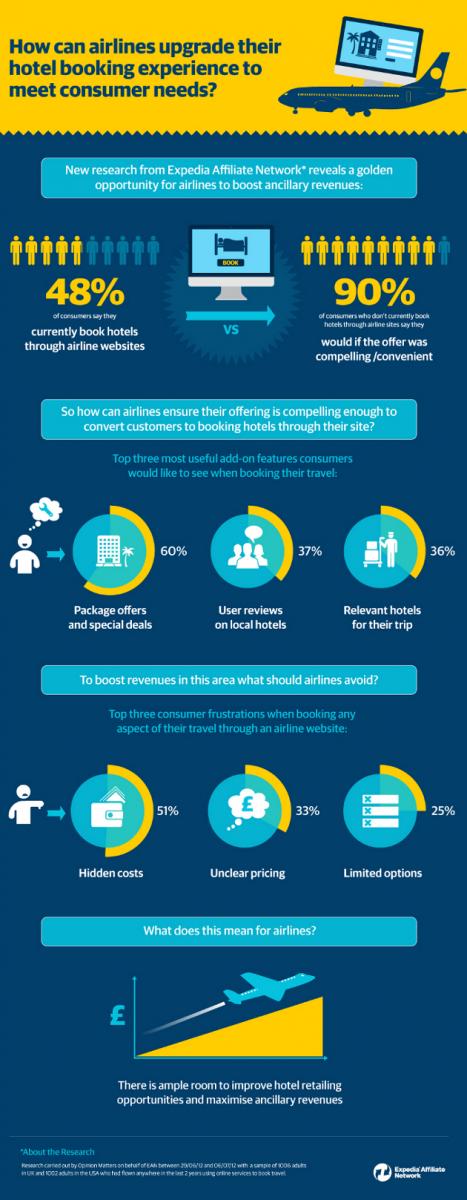Driving loyalty and increasing conversions with the right deal at the right time
Many airlines have a pretty good idea today of who their customer is and where they are going. They are also strongly focused on driving ancillary revenues. Research released today reveals that selling more hotels at the time of booking is an untapped market that could give the bottom line a boost, writes Pamela Whitby
Customers have a love-hate relationship with airlines. The hate bit was highlighted only too clearly by the recent Twitter campaign in Spain calling customers to boycott Irish low-cost airline Ryanair after a passenger was evicted from the aircraft for carrying on more than she could fit in her hand luggage. Ryanair has strict size and weight regulations for hand luggage.
While this incident shows just how quickly customers can turn against an airline, they are also willing to be loyal if the circumstances are favourable. As says Barry Landes, Airline Partnership Director at Expedia Affiliate Network (EAN) Americas points out many customers will do anything for more air miles.
When it comes to driving loyalty then, airlines, as EAN’s research highlights, could be missing a trick when it comes to loyalty-driven hotel offers. The most interesting piece of the research released today, says Landes, is that of the 2,000 people interviewed in the US and UK, almost half said they had booked a hotel via an airline’s website. But of those that hadn’t, 90% they would be happy to do so if there was a sufficiently compelling offer. “This is clearly an untapped market,” he says, and one which EAN, with its access to Hotels.com and Expedia’s huge inventory, hopes to help airlines address – at a price of course.
But it could be worth the investment. The airlines already know who their customer is, where they are going and why they are flying. With this information alone, they are able to start being more personal and some are already doing this. But they can go further. For Landes it is about making the offer as compelling, convenient and simple as possible. This can be done by developing anything from loyalty programmes linked to hotel offers at the time of booking to mobile-only deals, carefully targeted emails to a frequent flier list and working with other relevant partners.
Loyalty does work
Those airlines offering well thought out loyalty programmes, according to Landes, can improve conversions by two to three times and they are more likely to drive repeat bookings too. With one of its partners, EAN says increased conversions by 70% in the first week of the programme. Admittedly the first week of such a campaign is usually the most successful.
EAN is looking at how it can help airlines deliver a range of different deals and promotions at the time of booking. One area of focus is the mobile-only deal or promotion and how airlines integrate these into existing mobile platforms. There is some debate as to whether such offers will work and Landes admits that the jury is still out but the rapid growth of mobile is something that cannot be ignored.
On all fronts, however, the holy grail is ‘big data’ and using the knowledge you have of the customer at the time of booking (where they are going, how long they are staying, the ticket class and so on) to cross-sell in smart way, say Landes. So a business traveller will be targeted with a different hotel to a family on a half-term break. Relevance, as EyeforTravel talked about in a previous interview with EAN, and how you achieve this will be key. But that can be taken further still. Knowing who exactly your consumer is – their nationality, for example, may influence the way the book and pay for travel as EyeforTravel’s recent consumer research shows - is fundamentally important. For example, the French are more likely than the Germans, Dutch, Brits or Americans to book a last-minute trip. But the Dutch are happiest to book a trip via a smartphone.
Top tips
Some airlines are already doing things right and US-based United Airlines is one carrier that has worked with EAN on their non-air ancillary offerings. Landes says United has a very strong offering and utilises several examples of best-practice techniques. These include:
1. Displaying separate booking tabs on its homepage for all its non-air products.
2. Integrating non-air ancillary offerings into the loyalty programme.
3. Allowing customers to use loyalty points to book non-air products, as well as earn loyalty points on purchased products. This drives additional brand loyalty.
For more detail on the research findings take a look at this Infographic.


